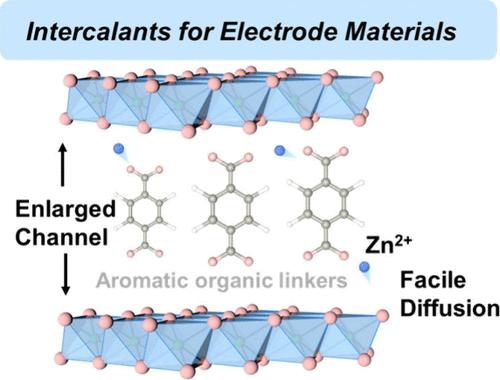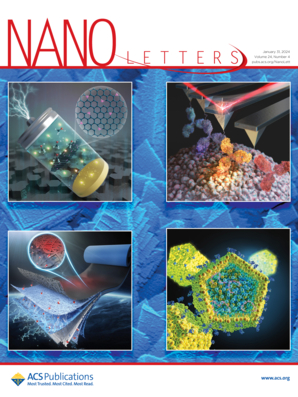Metal-Hydroxide Organic Frameworks for Aqueous Nickel-Zinc Batteries
IF 9.6
1区 材料科学
Q1 CHEMISTRY, MULTIDISCIPLINARY
引用次数: 0
Abstract
Hydroxides exhibit a high theoretical capacity for energy storage by ion release and are often intercalated with anions to enhance the ion migration kinetics. In this study, a series of metal-hydroxide organic frameworks (MHOFs) are synthesized by intercalating aromatic organic linkers into hydroxides using I-M/Ni(OH)2 (where M = Co2+, Cu2+, Mg2+, Fe2+). The coordination environment and layer spacing (1.09 nm) of I-M/Ni(OH)2 are explored by X-ray absorption fine structure and cryo-electron microscopy. The intercalation nanostructure improves the conductivity of the hydroxides and facilitates Zn2+ migration by increasing the interlayer spacing, while enhancing the rate capability and cycling stability. Consequently, the I-Co/Ni(OH)2 material exhibites a satisfactory specific capacity of 0.35 mAh cm–2 at 3 mA cm–2 and a high peak power density of 6.78 mW cm–2. This study offers a novel perspective on the design of intercalated hydroxide and provides new insights into high-performance nickel-zinc batteres.

用于水性镍锌电池的金属氢氧化物有机框架
氢氧化物通过离子释放显示出很高的理论储能能力,通常与阴离子插层以增强离子迁移动力学。本研究利用 I-M/Ni(OH)2(其中 M = Co2+、Cu2+、Mg2+、Fe2+)将芳香族有机连接体插层到氢氧化物中,合成了一系列金属氢氧化物有机框架(MHOFs)。通过 X 射线吸收精细结构和冷冻电镜研究了 I-M/Ni(OH)2的配位环境和层间距(1.09 nm)。插层纳米结构提高了氢氧化物的导电性,并通过增加层间距促进了 Zn2+ 的迁移,同时提高了速率能力和循环稳定性。因此,I-Co/Ni(OH)2 材料在 3 mA cm-2 条件下的比容量达到了令人满意的 0.35 mAh cm-2,峰值功率密度高达 6.78 mW cm-2。这项研究为插层氢氧化物的设计提供了一个新的视角,并为高性能镍锌电池提供了新的见解。
本文章由计算机程序翻译,如有差异,请以英文原文为准。
求助全文
约1分钟内获得全文
求助全文
来源期刊

Nano Letters
工程技术-材料科学:综合
CiteScore
16.80
自引率
2.80%
发文量
1182
审稿时长
1.4 months
期刊介绍:
Nano Letters serves as a dynamic platform for promptly disseminating original results in fundamental, applied, and emerging research across all facets of nanoscience and nanotechnology. A pivotal criterion for inclusion within Nano Letters is the convergence of at least two different areas or disciplines, ensuring a rich interdisciplinary scope. The journal is dedicated to fostering exploration in diverse areas, including:
- Experimental and theoretical findings on physical, chemical, and biological phenomena at the nanoscale
- Synthesis, characterization, and processing of organic, inorganic, polymer, and hybrid nanomaterials through physical, chemical, and biological methodologies
- Modeling and simulation of synthetic, assembly, and interaction processes
- Realization of integrated nanostructures and nano-engineered devices exhibiting advanced performance
- Applications of nanoscale materials in living and environmental systems
Nano Letters is committed to advancing and showcasing groundbreaking research that intersects various domains, fostering innovation and collaboration in the ever-evolving field of nanoscience and nanotechnology.
 求助内容:
求助内容: 应助结果提醒方式:
应助结果提醒方式:


